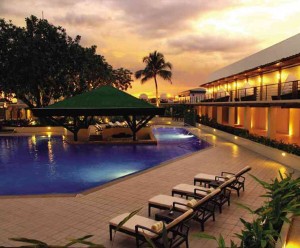From the many secrets its walls used to hold, to the beautiful bay sunsets, its inspiring historied past and modern twists, Manila remains to be a city to reckon with.
Indeed, the City of Manila continues to be relevant to the pressing demands of both the old and new generations, remaining to be the political and economic heart of the country, without losing that elegant, rustic charm that has drawn many foreign and local tourists, investors and ambitious minds alike.
One establishment has remained witness to Manila’s dynamic and colorful past, serving as the perfect landmark for a city that has played a huge role in defining the country’s rich history.

BY CONTINUOUSLY improving its facilities, Manila Hotel has managed to remain relevant to today’s market.
Manila Hotel, for one, has proven to be more than just a luxury establishment, having housed many notable personalities the likes of General Douglas MacArthur, heads of various states, and even celebrities, over the past decades—thus making it a unique and exciting destination, says the hotel’s executive vice president Enrique Yap.
Yap—who joined Manila Hotel nine years ago and previously worked under the direct supervision of the hotel’s former chair, the late Don Emilio Yap—was well aware that keeping the Manila Hotel brand afloat would be quite a challenge. This was amid the influx of new hotels in other cities across the country.
“One has to understand that Manila used to be the country’s center with the Hotel at the heart of the historical quarter. The biggest and richest families lived and partied here,” Yap explains.
“However, as with other major cities around the world, development has moved to the other areas outside of the capital. The center of commerce eventually moved to Makati—taking both big businesses and influential people away from Manila. Over time, Manila has become part of the periphery of what is now considered the country’s center,” he further shares.
The challenge now, according to Yap, lies on how the Manila Hotel would be able to create reasons for people to travel the additional 10 or 12 kilometers from Makati to the end of Roxas Boulevard where Manila Hotel is located. He however stresses that the hotel’s location is actually one of its prime advantages.
“Our bayside location and proximity to areas like the Rizal Park allow us to host huge events like the recently concluded Shell Eco-Marathon Asia 2014, which would have faced difficulty if it were held in a more densely populated area,” he says.
To address the changing and more demanding needs of the market, Manila Hotel has started to implement new programs, and other innovative measures to steer forward the “Grand Dame” and ensure that this national heritage will be able to keep up with new and more modern hotels.
Yap explains that Manila Hotel’s physical transformation started a few years ago when its tower and the Café Ilang Ilang were renovated. This was then followed by last year’s changes at the Centennial Hall. The Fiesta Pavilion, the Maynila Ballroom and the Millennium Salon, he adds, will likewise undergo similar changes this year.
“It’s a matter of repurposing spaces—making them smarter and more efficient so that they contribute to our guests’ overall experience. We have also changed the look of our service teams, as they now wear colonial period-inspired costumes that tell the hotel’s story and the country’s heritage,” Yap shares. “Regardless of how we look, guests are assured that our facilities and amenities are modern to meet and even exceed their requirements.”
Currently at the helm of running hotel operations, Yap explains that the most crucial task for now would be the challenge of differentiation, as the hotel needs to stand out in such a competitive industry where more chain and boutique hotels are being established.
“Today’s customers have evolved. Their expectations on their experiences have changed over time. Clearly, guests did not need high-speed Internet access in the ’30s nor did they require Wi-Fi for their smartphones. They take better care of themselves now, thus the need to provide healthier choices and activities,” Yap says.
“Even the chain of business has changed, as guests use the Internet in booking and arranging their stay directly with their hotel of choice. The rebranding initiatives have been put in place so that we strengthen our brand while becoming more responsive to changing customer preferences. We have realized that we have been unable to make full use of our heritage to our advantage and efforts are already underway to enhance what the Hotel has at its core,” he further explains.
But despite all these challenges, Yap admits that managing a heritage brand such as Manila Hotel also has its rewards.
“The Manila Hotel has long been established before the family started to manage it and it will remain a part of the country’s history long after I have gone. We are working toward making the hotel a globally admired establishment again where exemplary celebrations are held. Ultimately, our goal is for the hotel to be a source of pride for all Filipinos,” he relates.
“In terms of how ‘rewarding’ it is to be part of the Manila Hotel brand, we often liken it to owning a Patek Philippe—you don’t really own it, you are merely taking care of it for the next generation. My role is to keep the hotel relevant with today’s dynamic environment and hopefully my son can take over after 20 or so years,” Yap concludes.


